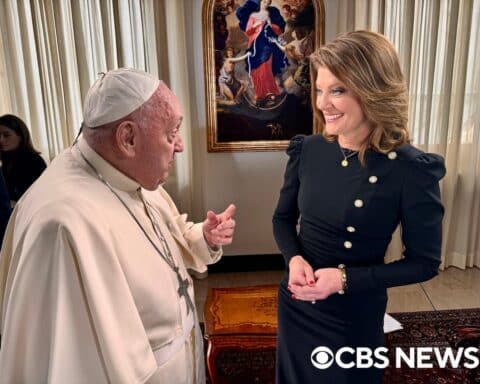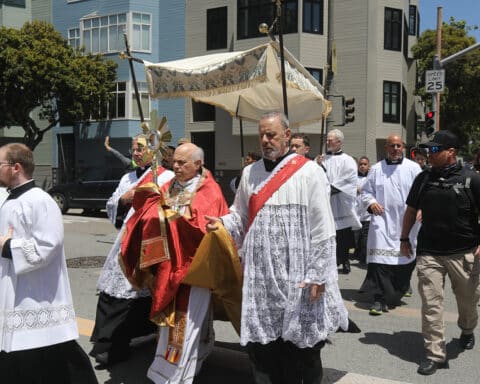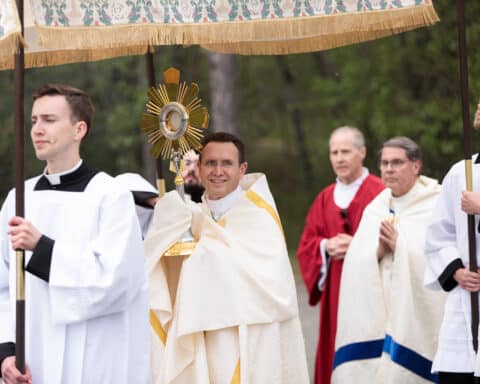DANVILLE, Ind. (OSV News) — The thrill couldn’t get any better — or so Forrest Tucker thought.
As a longtime welder for the Indianapolis Motor Speedway and as a talented sculptor, Tucker was honored to be asked to create a lasting tribute to the four race car drivers who have won the Indianapolis 500 four times.
Beginning in 2019, Tucker has sculpted four bronze bricks in honor of A. J. Foyt, Al Unser Sr., Rick Mears and Hélio Castroneves, with their names and the years they won the race on the bricks, which have been placed among the Speedway’s original red bricks at the start-finish line.
“To do something in the racing world that is part of the history of the Speedway — and my part will be there long after I’m gone — it’s the honor of a lifetime,” said the now-retired, 65-year-old Tucker, a member of Mary, Queen of Peace Parish in Danville. “I got a chance to meet the drivers and had some good conversations with them. I got a really close look at who they are as people. They’re all unique, as Christ made us.”
While Tucker will always admire these four legends in the racing world, he has a deeper spiritual connection to someone he also regards as an American hero — someone who is on the path to potential sainthood, someone whose remarkable life has challenged Tucker to create a sculpture that captures the essence of that person.
Unexpected inspiration
This is the unlikely story of the connection between Tucker, a humble sculptor from the countryside of Hendricks County, and Father Augustus Tolton, who was born into slavery and overcame the racism of his country and his church to become a boundless source of hope, humanity and Christ’s love in the slums of Chicago in the late 19th century.
Father Tolton’s sainthood cause began in 2010. In 2019, Pope Francis declared him “venerable,” recognizing that he lived a life of heroic virtue. But Tucker didn’t know anything about the first recognized priest of African descent in the United States until he experienced a small, personal moment of doubt and fear in 2021.
At the time, Tucker’s friend, Cheryl Shockley, had organized a blood drive in honor of her youngest child, Jack Shockley, who was murdered in 2020, at age 24, during an attempted robbery outside a McDonald’s restaurant in Indianapolis.
But Tucker was reluctant to go to the blood drive. His wife of now 47 years, Dawn, has struggled with multiple sclerosis for most of their married life, and Tucker doesn’t like to leave her on weekends when he doesn’t have caregiver help. And the blood drive was in the gym at Christ the King Parish on the northside of Indianapolis, a long drive from Danville. Then there were the facts that he had never donated blood and he wasn’t fond of needles.
Still, the pull of friendship with Cheryl and her husband, Steve, finally made him go.
“Cheryl was greeting people as they came in,” Tucker recalled in an interview with The Criterion, newspaper of the Archdiocese of Indianapolis. “She had a table full of prayer cards and pictures of saints. And one of the prayer cards was Father Tolton. She asked me if I’d ever heard of Father Tolton. I said no. She said, ‘Forrest, I think we need to pray to Father Tolton. We need prayers for this country, for the healing — because there’s so much violence being done.'”
Deepening connection
“Cheryl is one of those persons when they say to do something, you say yes,” Tucker said. “So, I took a prayer card. When my number came up to give blood, I sat in the chair, and I was kind of nervous when I saw the tubes and needles. The technician told me to just relax. I decided to pray to Father Tolton. It just came to me. I closed my eyes and prayed to Father Tolton, who I knew nothing about.”
As he prayed, Tucker said, “I had the strongest image that came to my mind of Father Tolton with this grieving woman. It was so different and vivid and strong. It was just these two people in a moment. It was a strange thing that happened to me. There were 100 people in that gym. People were talking, and kids were throwing balls, but I didn’t hear any noise during that time. When I got up, I gave Cheryl a hug. I didn’t tell her about it.”
As he drove home, Tucker couldn’t get the image of Father Tolton and the grieving woman out of his mind. The father of three grown children also found himself wanting to learn all he could about Father Tolton.
Life of Father Augustus Tolton
Born to enslaved parents in Missouri, Augustus Tolton, two siblings and his mother, Martha Tolton, escaped slavery by crossing the Mississippi River to Illinois and freedom in 1862.
When the Civil War broke out, Augustus’ father, Peter, had escaped to serve with the Union Army but soon died of illness. His mother thereafter fled with young Augustus and his two siblings, rowing them across the Mississippi River to Illinois, eventually reaching Quincy, where they settled.
After working in a factory and attending Catholic schools (often facing harassment in the process), Augustus discerned a religious vocation. He moved to Rome in 1880 to study for the priesthood, since no seminary in the United States would accept him due to his race.
Upon his 1886 ordination, Father Tolton was sent back to the United States, first to Quincy and then later Chicago. Despite repeated rejection, he persisted in his pastoral work, founding St. Monica Parish on Chicago’s South Side. His reverence, humility, zeal and exceptional singing voice drew both Black and white Catholics from all economic classes. In 1897, Father Tolton collapsed from heat stroke July 8, 1897, and died the next day. He was 43.
“Perseverance comes to mind about him,” Tucker said. “Despite what he went through, the obstacles that were in his way, he never wavered in his faith. He let nothing separate him from God. That was one of the big takeaways for me.”
While Father Tolton’s life was marked by an undeniable perseverance, the image of him extending his hand in compassion to a grieving woman persisted in the mind of Tucker.
“At first, it didn’t even come to my mind that this was a sculpture,” Tucker said. “But I kept thinking about it. The image lingered, but I didn’t tell anybody about it, not even Dawn.”
Divine guidance
Tucker’s most personal pieces have always been related to the sacred.
One of his most impressive sculptures is of Christ’s crown of thorns, one of the special times that he believes the Holy Spirit was guiding his hands. So, he turned to the Holy Spirit for guidance about what he should do with his mental image of Father Tolton and the grieving woman.
“I was praying, ‘Holy Spirit, what am I supposed to do with this?’ The image was too complicated, too detailed. I don’t have the ability to do this as a sculpture. It’s way out of my league.
“The Spirit kept pulling me, and finally I said OK. I said I’ll sculpt this in clay, but it’s not going to look good. It won’t work out. But I said I’ll have faith.’
He started sculpting it in May 2022, working on it all summer and fall. In October, “I finally had a sculpture in clay of the image I saw,” he said, but he didn’t know what to do with it.
Recognition and validation
Conversations with two priests in the Archdiocese of Indianapolis led him to a meeting with the diocesan postulator for Father Tolton’s cause for sainthood — retired Auxiliary Bishop Joseph N. Perry of Chicago.
Bishop Perry invited Tucker to come to Chicago, and they met in April 2023.
“Forrest’s sculpture of Father Tolton is among the only few sculpted figures of Tolton over the years,” Bishop Perry told The Criterion. “When he showed me his clay model of the sculpture of Father Tolton extending his hand to a downtrodden woman, I immediately became aware that Forrest had captured the temperament of Father Tolton, who ministered all his priesthood to the abject poor in Quincy and in Chicago.”
Tucker “shares with Father Tolton those Christian attributes that have the power to change society and the world if people would struggle through their fears of one another,” said Bishop Perry, chairman of the U.S. Conference of Catholic Bishops’ Ad Hoc Committee Against Racism. “Forrest’s sculpture brings complement to this cause for sainthood of our beloved first priest of African descent to labor in the United States.”
Bringing the vision to life
After casting the sculpture in wax for six months, Tucker’s next step is bringing the sculpture to life in bronze. He plans to finish the process so he can share it with Bishop Perry when the shepherd comes to Indianapolis for the National Eucharistic Congress in July.
One of the questions that he gets regarding the sculpture of Father Tolton and the grieving woman is, “Who is the woman depicted in that moment?”
Tucker said it’s a mystery to him.
“Life can be pretty tough, and you can encounter some pretty tough obstacles,” Tucker said. “Yet no matter what happens to you, there’s nothing that can separate you from God.”
John Shaughnessy is assistant editor at The Criterion, newspaper of the Archdiocese of Indianapolis.





